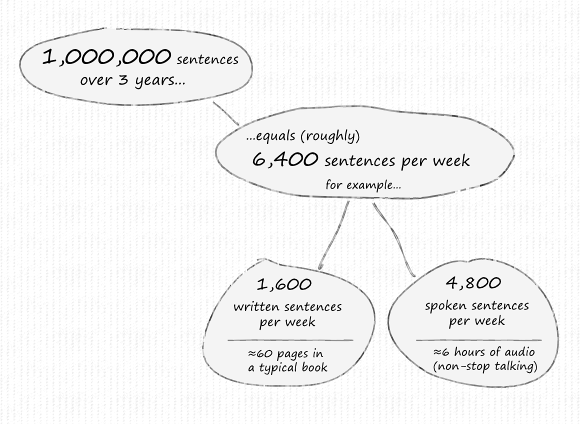English language learners have unique needs when it
comes to mathematics instruction. Find out about several key strategies to help
ELLs succeed.
For some students, math seems to be a foreign
language, consisting of words and concepts that don't mesh with their everyday
experiences. For these students, successful teachers find ways to make math
understandable, relevant, and familiar. In some ways, it is all about finding a
common language.
So what is a teacher to do when there truly is not a
common language shared between teacher and student?
Math classes for English Language Learners (ELLs) can be especially challenging because students are faced with learning both mathematics and English at the same time. Math teachers can and must make every effort to reach out to these students to create a class that is both positive and rewarding.
By employing the following strategies and techniques, you can help your ELL students increase their knowledge and understanding of math topics.
Math classes for English Language Learners (ELLs) can be especially challenging because students are faced with learning both mathematics and English at the same time. Math teachers can and must make every effort to reach out to these students to create a class that is both positive and rewarding.
By employing the following strategies and techniques, you can help your ELL students increase their knowledge and understanding of math topics.
Use Small Groups
The use of pairs or small groups is an instructional strategy that can be very effective for ELL students. By grouping students, you can:
·
encourage
communication and interaction in a non-threatening and more relaxed setting.
·
help students
feel more comfortable to ask questions or seek explanations.
·
promote a
positive support system for your ELL students.
·
manage large
classes with diverse student needs more effectively.
Vary Math Instruction and Provide Interesting Problems
As a math teacher of ELL students, it is important to utilize multiple instructional approaches and to consider the individual learning styles of your students. This will help you better meet the varied needs of your students. Try one or more of the following instructional strategies.
·
Manipulatives
and models. Where appropriate,
use models or manipulatives to demonstrate concepts and/or processes. Allow ELL
students to use them as well to demonstrate their learning.
·
Think-Alouds. Use a "think-aloud" technique to
narrate the problem-solving process (including algorithms).
·
Informal
language. To increase understanding, use informal
language as you demonstrate the various thought processes and steps to follow
in solving a problem.
·
Clarity checks. Be sure to check for understanding of the task
and processes involved before students get started working on the assignment.
ELL students often do not seek clarification for fear of calling attention to
themselves.
·
Context. Present activities that involve application
problems in contextualized situations. These activities should encourage
critical thinking and reasoning along with basic skills development and
practice. Engaging your ELL students in this way is important because it makes
learning relevant to the real-life experiences of your students. Sports,
entertainment, and games can be good themes to do this.
·
Diagrams and
Graphs. Encourage the use of diagrams and other
visual aids to help your ELL students develop concepts and understanding. For
written and verbal communication, increase your focus on reasoning and decrease
the focus on language. This emphasis can help to encourage your ELL students to
expand their mathematical abilities without getting bogged down with issues
related to language acquisition.
·
Assignments. Consider limiting the number of problems you
assign to ELLs to avoid overwhelming them. Focus on fewer problems that get at
essential concepts and skills.
Teach Math Vocabulary
Math classes can present extra challenges for ELL
students because they must learn the specific content vocabulary and
expressions, along with their second language acquisition. Help your ELL
students by directly teaching math vocabulary. Use the following ideas to plan
your vocabulary building activities.
·
Topical Terms. Identify and teach specific vocabulary that must
be understood for each assigned activity.
·
Common Math
Terms. Teach the meanings of common math terms
that have other definitions outside of the context of math-for example root,
face, mean, and prime.
·
Solutions. Create a plan for how you will help ELL students
acquire the language of mathematics.
·
Visual Aids. Consider using visual aids, multiple examples,
and student explanations as possible techniques to help your ELL students grasp
unfamiliar math terms.
·
Note Cards. Encourage your ELL students to keep note cards
to record math terms and vocabulary in their own words, sometimes with the use
of their native language. Remind your ELL students to reference these note
cards and to add to them as their understanding grows.
·
Math Journals. Use journals to practice and strengthen new
language skills and math terms in a non-threatening manner. Some ELL students
may feel comfortable using their native language in their journals as
a way to help solidify their understanding of math concepts.
Monitor Your Interactions with ELL Students
To help your ELL students follow lectures and
understand class discussions, you will need to be aware of your speech and
consider simplifying it when you can. Some ways to do this include:
Effective Communication
Strategies for Teachers
|
·
Pause frequently.
·
Paraphrase often.
·
Emphasize key ideas and vocabulary through intonation.
·
Write key terms and concepts on the board.
·
Use pronouns clearly.
·
Shorten sentences.
·
Increase wait time for students to answer and process information.
|
Use Prior Learning as a Starting Point
It is essential that you take into account the ELLs unique experiences, prior learning, and individual strengths to develop appropriate instructional strategies. Other cultures have different approaches to mathematics that even the ELL may be unaware of.
Mathematical Concepts
That May Differ or Be Difficult
|
|
Measurement
|
Measurement may be
especially challenging for ELL students, as their prior instruction most
likely covered the metric system.
|
Fractions
|
Fractions may be
unfamiliar to ELLs. Some ELL students may have come from an educational
environment where decimals received more emphasis than fractions.
|
Geometry
|
The discipline of
Geometry in particular has many terms that may cause difficulties in
understanding.
|
Algorithms
|
In some cases, algorithms
may have been learned differently. Some ELL students may be used to
algorithms that are different from traditional algorithms taught in your
curriculum. Allow students the opportunity to share their algorithms. Use
this as a learning opportunity by comparing algorithms and analyzing
similarities and differences.
|
Value Student Backgrounds to Improve Performance
Be aware of and draw from your ELL students' prior knowledge. You should:
·
Make sure ELL
students know that their experiences and culture are valued. This
will help their attitudes and increase their motivation.
·
Focus on
meaning. When your ELL students share answers and present ideas, remember to
focus on the meaning they are conveying, not on their grammar and usage.
·
Be flexible
with student use of native language. You may want to have your ELL
students record answers or solution steps in their own native language.
You can have their work translated, if desired. This will help ELL students
focus on the concepts and reasoning involved, without being slowed or hindered
by their developing language skills.
Multi-Stepped Problem
Lesson Idea
|
Present a multi-stepped problem to your class. Have your students identify the steps that they would need to undertake to solve the problem, but just identify the steps; do not have your students solve the problem. This will help ELL students practice their language skills by reading and interpreting problems. This type of exercise will help students practice language skills without worrying about solving the problem. This exercise can be used frequently as a quick warm-up activity. |
Success Is Possible
As a concerned math teacher, your instructional goal should be to facilitate full participation in all aspects of a rich mathematical educational experience for all students. You can do this by lessening or removing some of the barriers to learning that are connected to the process of second language acquisition. Keeping a few of these instructional strategies and techniques in mind can help you make your math instruction better for not just ELL students, but for all of your students.

